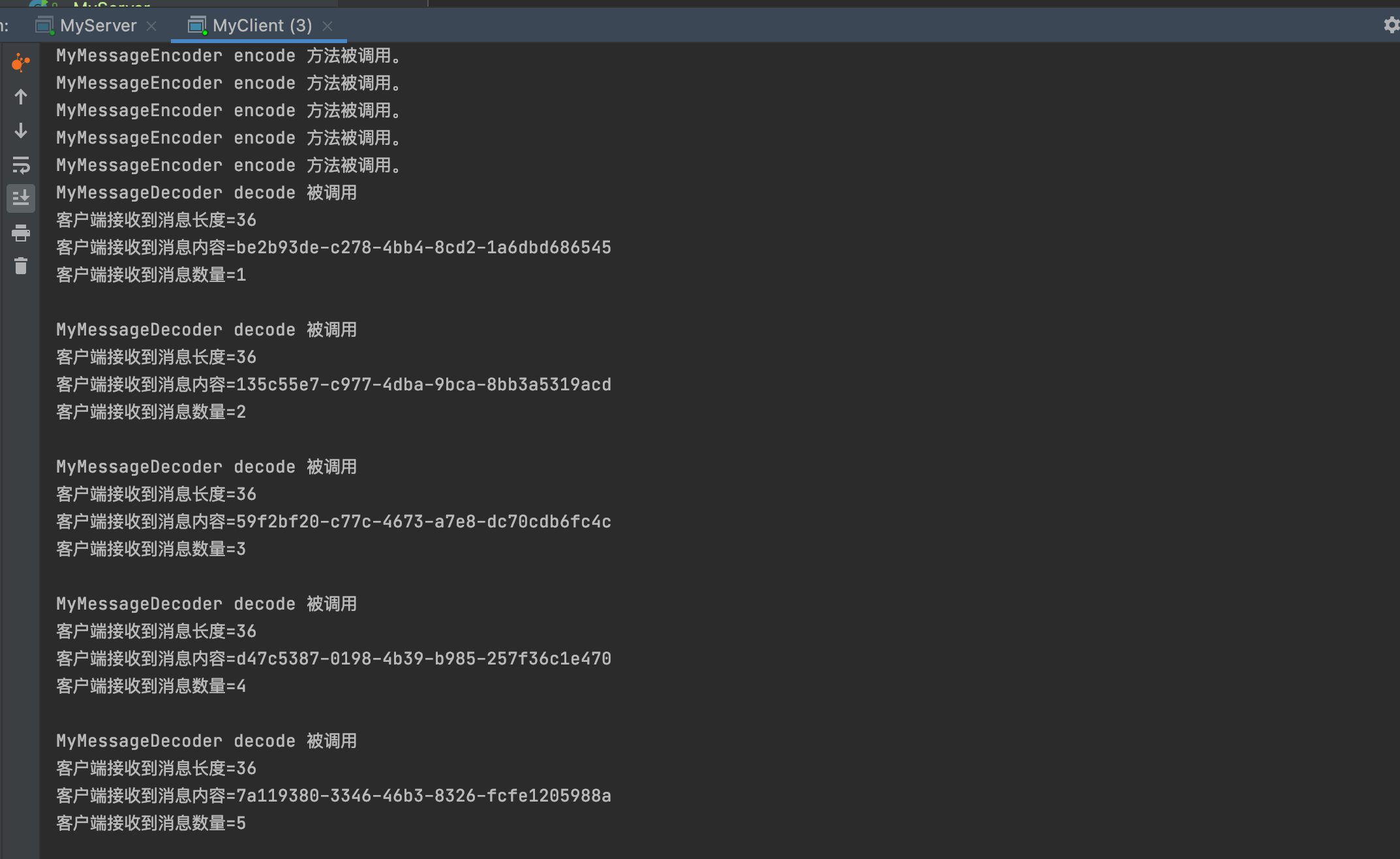一、基本介绍
- TCP 是面向连接的,面向流的,提供高可靠性服务。收发两端(客户端和服务器端)都要有一一成对的 socket,因此,发送端为了将多个发给接收端的包,更有效的发给对方,使用了优化方法(Nagle 算法),将多次间隔较小且数据量小的数据,合并成一个大的数据块,然后进行封包。这样做虽然提高了效率,但是接收端就难于分辨出完整的数据包了,因为面向流的通信是无消息保护边界的
- 由于 TCP 无消息保护边界,需要在接收端处理消息边界问题,也就是我们所说的粘包、拆包问题,看一张图
- TCP 粘包、拆包图解

假设客户端分别发送了两个数据包 D1 和 D2 给服务端,由于服务端一次读取到字节数是不确定的,故可能存在以下四种情况:
- 服务端分两次读取到了两个独立的数据包,分别是 D1 和 D2,没有粘包和拆包
- 服务端一次接受到了两个数据包,D1 和 D2 粘合在一起,称之为 TCP 粘包
- 服务端分两次读取到了数据包,第一次读取到了完整的 D1 包和 D2 包的部分内容,第二次读取到了 D2 包的剩余内容,这称之为 TCP 拆包
服务端分两次读取到了数据包,第一次读取到了 D1 包的部分内容 D1_1,第二次读取到了 D1 包的剩余部分内容 D1_2 和完整的 D2 包。
二、TCP粘包和拆包的现象实例
在编写 Netty 程序时,如果没有做处理,就会发生粘包和拆包的问题
看一个具体的实例:2.1 客户端
MyClient
public class MyClient {public static void main(String[] args) throws InterruptedException {NioEventLoopGroup group = new NioEventLoopGroup();try {Bootstrap bootstrap = new Bootstrap();bootstrap.group(group).channel(NioSocketChannel.class).handler(new MyClientInitializer());ChannelFuture channelFuture = bootstrap.connect("localhost", 9090).sync();channelFuture.channel().closeFuture().sync();} finally {group.shutdownGracefully();}}}
MyClientInitializer
public class MyClientInitializer extends ChannelInitializer<SocketChannel> {@Overrideprotected void initChannel(SocketChannel ch) throws Exception {ChannelPipeline pipeline = ch.pipeline();pipeline.addLast(new MyClientHandler());}}
MyClientHandler
public class MyClientHandler extends SimpleChannelInboundHandler<ByteBuf> {int count;@Overridepublic void channelActive(ChannelHandlerContext ctx) throws Exception {// 使用客户端发送10条数据 hello,serverfor (int i = 0; i < 10; i++) {ByteBuf byteBuf = Unpooled.copiedBuffer(" hello,server" + i, StandardCharsets.UTF_8);ctx.writeAndFlush(byteBuf);}}@Overrideprotected void channelRead0(ChannelHandlerContext ctx, ByteBuf msg) throws Exception {byte[] buffer = new byte[msg.readableBytes()];msg.readBytes(buffer);String message = new String(buffer, StandardCharsets.UTF_8);System.out.println("客户端接收到消息=" + message);System.out.println("客户端接收到消息数量=" + (++this.count));}@Overridepublic void exceptionCaught(ChannelHandlerContext ctx, Throwable cause) throws Exception {cause.printStackTrace();ctx.close();}}
2.2 服务端
MyServer
public class MyServer {public static void main(String[] args) throws InterruptedException {NioEventLoopGroup bossGroup = new NioEventLoopGroup();NioEventLoopGroup workGroup = new NioEventLoopGroup();try {ServerBootstrap serverBootstrap = new ServerBootstrap();serverBootstrap.group(bossGroup, workGroup).channel(NioServerSocketChannel.class).childHandler(new MyServerInitializer());ChannelFuture channelFuture = serverBootstrap.bind(9090).sync();channelFuture.channel().closeFuture().sync();} finally {bossGroup.shutdownGracefully();workGroup.shutdownGracefully();}}}
MyServerInitializer
public class MyServerInitializer extends ChannelInitializer<SocketChannel> {@Overrideprotected void initChannel(SocketChannel ch) throws Exception {ChannelPipeline pipeline = ch.pipeline();pipeline.addLast(new MyServerHandler());}}
MyServerHandler
public class MyServerHandler extends SimpleChannelInboundHandler<ByteBuf> {private int count;@Overrideprotected void channelRead0(ChannelHandlerContext ctx, ByteBuf msg) throws Exception {byte[] buffer = new byte[msg.readableBytes()];msg.readBytes(buffer);// 将buffer转化成字符串String message = new String(buffer, StandardCharsets.UTF_8);System.out.println("服务器端接收到数据 " + message);System.out.println("服务器端接收到消息次数 " + (++this.count));// 服务器会送数据给客户端,会送一个随机IdByteBuf byteBuf = Unpooled.copiedBuffer(UUID.randomUUID().toString()+" ", StandardCharsets.UTF_8);ctx.writeAndFlush(byteBuf);}@Overridepublic void exceptionCaught(ChannelHandlerContext ctx, Throwable cause) throws Exception {cause.printStackTrace();ctx.close();}}
2.3 输出效果
通过下图可以看到,MyClient一次性发出了10条消息,但是MyServer有时候是10条消息一起读取展示的,有时候是几条消息拆分展示的,这就会导致一个问题:接受消息时不知道消息头和消息尾,导致消息语义表达有误。



三、TCP 粘包和拆包解决方案
常用方案:使用自定义协议+编解码器来解决。 关键就是要解决服务器端每次读取数据长度的问题,这个问题解决,就不会出现服务器多读或少读数据的问题,从而避免的 TCP 粘包、拆包。
看一个具体的实例
要求客户端发送 5 个 Message 对象,客户端每次发送一个 Message 对象,服务器端每次接收一个 Message,分 5 次进行解码,每读取到一个 Message,会回复一个 Message 对象给客户端。
3.1 协议包
MessageProtocol
public class MessageProtocol {private int len;private byte[] content;public int getLen() {return len;}public void setLen(int len) {this.len = len;}public byte[] getContent() {return content;}public void setContent(byte[] content) {this.content = content;}}
3.2 编码解码器
MyMessageEncoder
// 编码器public class MyMessageEncoder extends MessageToByteEncoder<MessageProtocol> {@Overrideprotected void encode(ChannelHandlerContext ctx, MessageProtocol msg, ByteBuf out) throws Exception {System.out.println("MyMessageEncoder encode 方法被调用。");out.writeInt(msg.getLen());out.writeBytes(msg.getContent());}}
MyMessageDecoder
// 解码器public class MyMessageDecoder extends ReplayingDecoder<Void> {@Overrideprotected void decode(ChannelHandlerContext ctx, ByteBuf in, List<Object> out) throws Exception {System.out.println("MyMessageDecoder decode 被调用");// 需要将得到的二进制字节码 -> MessageProtocol 数据包对象int length = in.readInt();byte[] content = new byte[length];// 获取内容in.readBytes(content);// 封装成 MessageProtocol 对象 ,放入out,传递给下一个 handler 业务处理MessageProtocol messageProtocol = new MessageProtocol();messageProtocol.setLen(length);messageProtocol.setContent(content);out.add(messageProtocol);}}
3.3 客户端
MyClient
public class MyClient {public static void main(String[] args) throws InterruptedException {NioEventLoopGroup group = new NioEventLoopGroup();try {Bootstrap bootstrap = new Bootstrap();bootstrap.group(group).channel(NioSocketChannel.class).handler(new MyClientInitializer());ChannelFuture channelFuture = bootstrap.connect("localhost", 9090).sync();channelFuture.channel().closeFuture().sync();} finally {group.shutdownGracefully();}}}
�MyClientInitializer
public class MyClientInitializer extends ChannelInitializer<SocketChannel> {@Overrideprotected void initChannel(SocketChannel ch) throws Exception {ChannelPipeline pipeline = ch.pipeline();// 加入编码器pipeline.addLast(new MyMessageEncoder());// 解码器pipeline.addLast(new MyMessageDecoder());pipeline.addLast(new MyClientHandler());}}
MyClientHandler
public class MyClientHandler extends SimpleChannelInboundHandler<MessageProtocol> {int count;@Overridepublic void channelActive(ChannelHandlerContext ctx) throws Exception {// 使用客户端发送10条数据 "今天天气冷,吃火锅" 编号for (int i = 0; i < 5; i++) {String msg = "你好呀。。。";byte[] content = msg.getBytes(StandardCharsets.UTF_8);int length = content.length;// 创建协议包MessageProtocol messageProtocol = new MessageProtocol();messageProtocol.setLen(length);messageProtocol.setContent(content);ctx.writeAndFlush(messageProtocol);}}@Overrideprotected void channelRead0(ChannelHandlerContext ctx, MessageProtocol msg) throws Exception {int len = msg.getLen();byte[] content = msg.getContent();String message = new String(content, StandardCharsets.UTF_8);System.out.println("客户端接收到消息长度=" + len);System.out.println("客户端接收到消息内容=" + message);System.out.println("客户端接收到消息数量=" + (++this.count) + "\n");}@Overridepublic void exceptionCaught(ChannelHandlerContext ctx, Throwable cause) throws Exception {cause.printStackTrace();System.out.println("异常信息=" + cause.getMessage());ctx.close();}}
3.4 服务端
MyServer
public class MyServer {public static void main(String[] args) throws InterruptedException {NioEventLoopGroup bossGroup = new NioEventLoopGroup();NioEventLoopGroup workGroup = new NioEventLoopGroup();try {ServerBootstrap serverBootstrap = new ServerBootstrap();serverBootstrap.group(bossGroup, workGroup).channel(NioServerSocketChannel.class).childHandler(new MyServerInitializer());ChannelFuture channelFuture = serverBootstrap.bind(9090).sync();channelFuture.channel().closeFuture().sync();} finally {bossGroup.shutdownGracefully();workGroup.shutdownGracefully();}}}
MyServerInitializer
public class MyServerInitializer extends ChannelInitializer<SocketChannel> {@Overrideprotected void initChannel(SocketChannel ch) throws Exception {ChannelPipeline pipeline = ch.pipeline();// 解码器pipeline.addLast(new MyMessageDecoder());// 编码器pipeline.addLast(new MyMessageEncoder());pipeline.addLast(new MyServerHandler());}}
MyServerHandler
public class MyServerHandler extends SimpleChannelInboundHandler<MessageProtocol> {private int count;@Overrideprotected void channelRead0(ChannelHandlerContext ctx, MessageProtocol msg) throws Exception {// 接收到数据 并处理int len = msg.getLen();byte[] content = msg.getContent();System.out.println("服务器接收到信息如下");System.out.println("长度=" + len);System.out.println("内容=" + new String(content, StandardCharsets.UTF_8));System.out.println("服务器接收到消息包数量 " + (++this.count) + "\n");// 回复消息String responseContent = UUID.randomUUID().toString();byte[] responseContentBytes = responseContent.getBytes(StandardCharsets.UTF_8);int length = responseContentBytes.length;// 构建一个协议包MessageProtocol messageProtocol = new MessageProtocol();messageProtocol.setContent(responseContentBytes);messageProtocol.setLen(length);ctx.writeAndFlush(messageProtocol);}@Overridepublic void exceptionCaught(ChannelHandlerContext ctx, Throwable cause) throws Exception {cause.printStackTrace();ctx.close();}}
3.5 输出效果
如下是服务端和客户端的输出,可以看到消息没有乱,根据每个协议包输出的。
无论运行几次,Server都是分5次接收的,这样就解决了TCP粘包问题。


